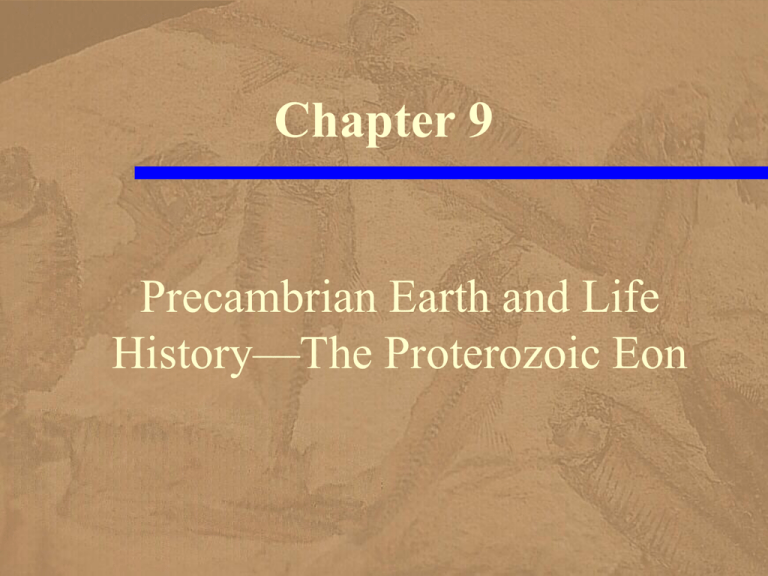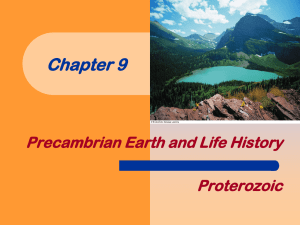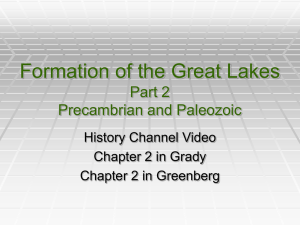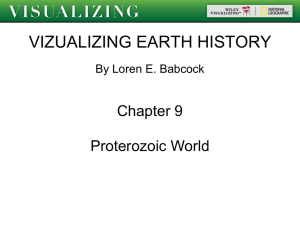Chapter 9
advertisement

Chapter 9 Precambrian Earth and Life History—The Proterozoic Eon Proterozoic Rocks, Glacier NP • Proterozoic rocks – of the Belt Supergroup, Glacier National Park, Montana – were deposited as sediments • in marine and terrestrial environments – and deformed during the Cretaceous to Early Cenozoic Laramide orogeny The Length of the Proterozoic • The Proterozoic Eon alone, – at 1.958 billion years long, – accounts for 42.5% of all geologic time – yet we review this long episode of Earth and life history in a single chapter The Phanerozoic • The Phanerozoic, – consisting of • Paleozoic, • Mesozoic, • Cenozoic eras, – lasted a comparatively brief 542 million years – but is the subject of 10 chapters! Disparity in Time • Precambrian rocks are deeply buried – in many areas. – Many have been metamorphosed and complexly deformed. • The Proterozoic Eon is subdivided – into three eras – with prefixes Paleo, Meso, and Neo – which are strictly terms denoting time Proterozoic Rocks • The Vishnu schist in the Grand Canyon – was originally lava flows and sedimentary rocks, but – was intruded by the Zoraster Granite – 1.7 billion years ago Proterozoic Rocks • The outcrop of sandstone and mudstone – 1.0 billion years old – has only been slightly altered by metamorphism Archean-Proterozoic Boundary • Geologists have rather arbitrarily placed – – – – the Archean-Proterozoic boundary at 2.5 billion years ago because it marks the approximate time of changes in the style of crustal evolution • However, we must emphasize "approximate," – because Archean-type crustal evolution – was not completed at the same time – in all areas Style of Crustal Evolution • Archean crust-forming processes generated – granite-gneiss complexes – and greenstone belts – that were shaped into cratons • Although these same rock associations – continued to form during the Proterozoic, – they did so at a considerably reduced rate Archean vs. Proterozoic • Many Archean rocks have been metamorphosed, • However, vast exposures of Proterozoic rocks – Are unaltered or nearly so, • In many areas Archean rocks are separated from Proterozoic rocks – by an unconformity • Widespread associations of sedimentary rocks of passive continental margins – were deposited during the Proterozoic – by a plate tectonic style essentially the same as it is now Other Differences • The Proterozoic was also a time in evolution of – the atmosphere and biosphere – as well as the origin of some important natural resources • Oxygen-dependent organisms – evolved during this time • The first multicelled organisms and animals – made their appearance. • The fossil record is still poor compared to the Phanerozoic Evolution of Proterozoic Continents • Archean cratons assembled during collisions – – – – of island arcs and minicontinents, providing the nuclei around which Proterozoic crust accreted, thereby forming much larger landmasses • Proterozoic accretion – probably took place more rapidly than today – because Earth possessed more radiogenic heat, – and the plates moved faster Focus on Laurentia • Our focus here is on the geologic evolution of Laurentia, – a large landmass that consisted of what is now • North America, • Greenland, • parts of northwestern Scotland, • and perhaps some of the Baltic shield of Scandinavia Proterozoic Greenstone Belts • Most greenstone belts formed – during the Archean • They also continued to form – during the Proterozoic and at least one is known – from Cambrian-aged rocks in Australia • They were not as common after the Archean, – and differed in one important detail • the near absence of ultramafic rocks, komatiites, • which no doubt resulted from • Earth's decreasing amount of radiogenic heat production Early Proterozoic History of Laurentia • Laurentia underwent important changes – between 2.0 and 1.8 billion years ago • During this time, collisions – among various plates formed several orogens, – which are linear or arcuate deformation belts – in which many of the rocks have been • metamorphosed • and intruded by magma • thus forming plutons, especially batholiths Proterozoic Evolution of Laurentia • Archean cratons were sutured – – – – – along these orogens, thereby forming a larger landmass which makes up much of Greenland, central Canada, and the north-central United States Craton-Forming Processes • Examples of these craton-forming processes – are recorded in rocks – in the Thelon orogen in northwestern Canada • where the Slave and Rae cratons collided, Craton-Forming Processes • the Trans-Hudson orogen • in Canada and the United States, – where the Superior, Hearne, and Wyoming cratons – were sutured • The southern margin of Laurentia – is the site of the Penokean orogen Wilson Cycle • Rocks of the Wopmay orogen – – – – in northwestern Canada are important because they record the opening and closing of an ocean basin or what is called a Wilson cycle • A complete Wilson cycle, • named for the Canadian geologist J. Tuzo Wilson, – involves • rifting of a continent, • opening and closing of an ocean basin, • and finally reassembly of the continent Wilson Cycle • Some geologists think that the Wopmay orogen – represents a complete Wilson cycle Wopmay Orogen • Some of the rocks in Wopmay orogen – are sandstonecarbonate-shale assemblages, – a suite of rocks typical of passive continental margins – that first become widespread during the Proterozoic Early Proterozoic Rocks in Great Lakes Region • Early Proterozoic sandstone-carbonate-shale assemblages are widespread near the Great Lakes Outcrop of Mesnard Quartzite • The crests of the ripple marks – point toward the observer Outcrop of Kona Dolomite • The bulbous structures – are stromatolites – that resulted from the activities – of cyanobacteria. Penokean Orogen • These rocks of the Great Lakes region – of the United States and Canada – includes sandstone-carbonate shale assemblages Accretion along Laurentia’s Southern Margin • Following the initial episode – of amalgamation of Archean cratons – accretion took place along Laurentia's southern margin – as it collided with volcanic island arcs and oceanic terranes • From 1.65 to 1.76 billion years ago, – the Yavapai and Mazatzal orogens were added to the evolving continent • The rocks have been deformed, altered by metamorphism, intruded by granitic batholiths, and – incorporated into Laurentia. Southern Margin Accretion • Laurentia grew along its southern margin – by accretion of the Central Plains, Yavapai, and Mazatzal orogens BIF, Red Beds, Glaciers • This was also the time during which – most of Earth’s banded iron formations (BIF) – were deposited • The first continental red beds – sandstone and shale with oxidized iron – were deposited • A significant Paleoproterozoic event was a – huge meteorite impact that took place in – northern Ontario, Canada • In addition, some Early Proterozoic rocks – and associated features provide excellent evidence – for widespread glaciation Mesoproterozoic Accretion and Igneous Activity • During the interval – – – – from 1.35 to 1.55 billion years ago, extensive igneous activity took place that seems to be unrelated to orogenic activity and accounted for the addition of the Granite-Rhyolite province • Some of the igneous activity resulted in – plutons being emplaced in existing continental crust. • The resulting igneous rocks are exposed in eastern Canada – extend across Greenland, – and are also found in the Baltic Shield, Scandinavia Granite-Rhyolite province • The last episodes in the Proterozoic accretion of Laurentia – involved the origin of the Granite-Rhyolite province – and the Grenville-Llano provinces Igneous Activity • However, the igneous rocks are deeply buried – by younger rocks in most areas • The origin of these – granitic and anorthosite plutons, • Anorthosite is a plutonic rock composed • almost entirely of plagioclase feldspars – calderas and their fill, – and vast sheets of rhyolite and ash flows – are the subject of debate • According to one hypothesis – large-scale upwelling of magma – beneath a Proterozoic supercontinent – produced the rocks Mesoproterozoic Orogeny and Rifting • A Mesoproterozoic event in Laurentia – was the Grenville orogeny – in the eastern part of the evolving continent – 1.3 to 1.0 billion years ago • Grenville rocks are well exposed – in the present-day northern Appalachian Mountains – as well as in eastern Canada, Greenland, and Scandinavia – The Llano province in Texas is probably • A westward extension of the Grenville. Grenville Orogeny • Rocks of the Grenville Orogen – These metamorphic rocks are uncomformably overlain – by the Upper Cambrian Potsdam Formation. Grenville Orogeny • Many geologists think the Grenville orogen – resulted from closure of an ocean basin, • the final stage in a Wilson cycle • The Grenville may have been the final episode – – – – in the assembly of the supercontinent Rodinia Whatever the cause of the Grenville orogeny, it was the final stage in the Proterozoic continental accretion of Laurentia 75% of North America • By this final stage, about 75% – of present-day North America existed • The remaining 25% – accreted along its margins, – particularly its eastern and western margins, – during the Phanerozoic Eon Midcontinent Rift • Beginning 1.1 billion years ago – tensional forces opened the Midcontinent rift, • a long narrow continental trough bounded by faults, • extending from the Lake Superior basin southwest into Kansas, • and a southeasterly branch extends through Michigan into Ohio • It cuts through Archean and Proterozoic rocks – and terminates against the Grenville orogen – in the east Location of the Midcontinent Rift • Rocks filling the rift – are exposed around Lake Superior – but are deeply buried elsewhere Midcontinental Rift • Most of the rift is buried beneath younger rocks – except in the Lake Superior region – where various igneous and sedimentary rocks – are well exposed • The central part of the rift contains – numerous overlapping basalt lava flows • forming a volcanic pile several kilometers thick • Although not all geologists agree, many think – That the Midcontinent rift is a failed rift – where Laurentia began splitting apart Midcontinental Rift • Along the rift's margins – – – – – conglomerate was deposited in large alluvial fans that grade into sandstone and shale with increasing distance from the sediment source • In the vertical section – Freda Sandstone overlies – Cooper Harbor conglomerate, – which overlies Portage Lake Volcanics Cooper Harbor Conglomerate Portage Lake Volcanics Michigan Meso- and Neoproterozoic Sedimentation • Remember the Grenville orogeny – took place 1.3 and 1.0 billion years ago, – the final episode of large-scale deformation – in Laurentia until the Ordovician Period • Nevertheless, important geologic events – – – – were taking place, such as sediment deposition in what is now the eastern United States and Canada, in the Death Valley region of California and Nevada, – and in three huge basins in the west Sedimentary Basins in the West • Meso- to Neoproterozoic basin – in the western United States and Canada • Belt Basin • Uinta Basin • Apache Basin Sedimentary Rocks • Meso- and Neoproterozoic sedimentary rocks – are exceptionally well exposed – in the northern Rocky Mountains – of Montana and Alberta, Canada • Indeed, their colors, deformation features, – and erosion by Pleistocene and recent glaciers – have yielded some fantastic scenery • Like the Paleoproterozoic rocks in the Great Lakes region – they are mostly sandstones, shales, – and stromatolite-bearing carbonates Belt Basin, Glacier National Park • Meso- and Neoproterozoic rocks in the Belt basin Rocks of the Uinta Mountain Group Utah Proterozoic Sandstone • Proterozoic rocks – – – – of the Grand Canyon Super-group lie unconformably upon Archean rocks and in turn are overlain unconformably by Phanerozoic-age rocks • The rocks, consisting mostly – of sandstone, shale, and dolostone, – were deposited in shallow-water marine – and fluvial environments • The presence of stromatolites and carbonaceous – impressions of algae in some of these rocks – indicate probable marine deposition Grand Canyon Super-group • Neoproterozoic sandstone in the Grand Canyon Proterozoic Supercontinents • A continent is a landmass – made up of granitic crust – with much of its surface above sea level • A supercontinent consists of – at least two continents merged into one, but usually includes – all or most of all Earth’s landmasses • The supercontinent Pangaea, – which existed at the end of the Paleozoic Era, – is familiar, – but few people are aware of earlier supercontinents Style of Plate Tectonics • The present style of plate tectonics – involving opening and then closing ocean basins – had almost certainly been established by the Paleoproterozoic • In fact, the oldest known ophiolites – providing evidence for an ancient convergent plate boundaries – are known from Neoarchean and Paleoproterozoic rocks of Russia and probably China • They compare closely with younger, well-documented ophiolites, – such as the Jormua mafic-ultramafic complex in Finland Jormua Complex, Finland • Reconstruction – of the highly deformed – Jormua maficultramafic complex – in Finland • This sequence of rock – is one of oldest known complete ophiolites – at 1.96 billion years old Jormua Complex, Finland • Metamorphosed basaltic pillow lava 12 cm Jormua Complex, Finland • Metamorphosed gabbro between mafic dikes 65 cm Early Supercontinents • Supercontinents may have existed – as early as the Neoarchean, – but if so we have little evidence of them • The first that geologists recognize – with some certainty, known as Rodinia, – assembled between 1.3 and 1.0 billion years ago – and then began fragmenting 750 million years ago Early Supercontinent • Possible configuration – of the Neoproterozoic supercontinent Rodinia – before it began fragmenting about 750 million years ago Pannotia • Judging by the Pan-African orogeny – the large-scale deformation that took place – in what are now the Southern Hemisphere continents • Rodinia's separate pieces reassembled – and formed another supercontinent – Pannotia, about 650 million years ago • Fragmentation was underway again, – by the latest Proterozoic, about 550 million years ago, – giving rise to the continental configuration – that existed at the onset of the Phanerozoic Eon Ancient Glaciers • Very few instances of widespread glacial activity – have occurred during Earth history • The most recent one during the Pleistocene – 1.8 million to 10,000 years ago – is the best known, – but we also have evidence for Pennsylvanian glaciers – and two major episodes of Proterozoic glaciation Recognizing Glaciation • How can we be sure that there were Proterozoic glaciers? – – – – Their most common deposit, called tillite, is simply a type of conglomerate that may look much like conglomerates originating from other processes • Tillite or tillite-like deposits are known – from at least 300 Precambrian localities, – and some of these are undoubtedly not glacial deposits Glacial Evidence • But the extensive geographic distribution – of other conglomerates – and their associated glacial features – is distinctive, – such as striated and polished bedrock Proterozoic Glacial Evidence • Tillite in Norway – overlies striated bedrock surface of sandstone Geologists Convinced • Geologists are now convinced • based on this kind of evidence – that widespread glaciation – took place during the Paleoproterozoic • The occurrence of tillites of about the same age – in Michigan, Wyoming, and Quebec – indicates that North America may have had – an ice sheet centered southwest of Hudson Bay Early Proterozoic Glaciers • Deposits in North America – indicate that Laurentia – had an extensive ice sheet – centered southwest of Hudson Bay Glaciers of the Late Proterozoic • Tillites and other glacial features – dating from between 900 and 600 million years ago – are found on all continents except Antarctica • Glaciation was not continuous during this entire time – but was episodic with four major glacial episodes so far recognized Late Proterozoic Glaciers • The approximate distribution of Neoproterozoic glaciers Most Extensive Glaciation in Earth History • The map shows only approximate distribution – of Neoproterozoic glaciers – The actual extent of glaciers is unknown • Not all the glaciers were present at the same time • Despite these uncertainties, – this Neoproterozoic glaciation – was the most extensive in Earth history • In fact, Neoproterozoic glaciers – seem to have been present even – in near-equatorial areas Snowball Earth? • Some geologists think that glaciers covered all land – and all seas were frozen – a snowball Earth • This hypothesis is controversial – but proponents claim that onset of this glacial episode – may have been triggered by the near-equatorial location of the continents – Accelerated weathering would absorb huge quantities of CO2 – With little CO2 glaciers would form and reflect solar radiation • back into space – More glacial ice would form Snowball Earth? • Volcanoes would continue spewing gases, which – would warm the atmosphere and end – the glacial episode • One criticism of the snowball Earth hypothesis: How would life survive? – Suggestions include • • • • Life persisted at hydrothermal vents on the seafloor Photosynthesis can take place beneath thin glacial ice Life may have persisted in subglacial lakes There may have been pools of water near volcanoes The Evolving Atmosphere • Geologists agree that the Archean atmosphere – contained little or no free oxygen so the atmosphere – was not strongly oxidizing as it is now • Even though processes were underway – – – – that added free oxygen to the atmosphere, the amount present at the beginning of the Proterozoic was probably no more than 1% of that present now • In fact, it might not have exceeded – 10% of present levels even – at the end of the Proterozoic Cyanobacteria and Stromatolites • Remember that cyanobacteria, – were present during the Archean, – but stromatolites • the structures they formed, – did not become common until about 2.3 billion years ago, • that is, during the Paleoproterozoic • These photosynthesizing organisms – and to a lesser degree, photochemical dissociation • added free oxygen to the evolving atmosphere Oxygen Versus Carbon Dioxide • Earth's early atmosphere – had abundant carbon dioxide • More oxygen became available – whereas the amount of carbon dioxide decreased • Only a small amount of CO2 – still exists in the atmosphere today • It is one of the greenhouse gases – partly responsible for global warming Evidence from Rocks • Much carbon dioxide is now tied up – in various minerals and rocks • especially the carbonate rocks – limestone and dolostone, – and in the biosphere • For evidence that the Proterozoic atmosphere was evolving – from a chemically reducing one – to an oxidizing one • we must discuss types – of Proterozoic sedimentary rocks, in particular – banded iron formations – and red beds Banded Iron Formations (BIF) • Banded iron formations (BIFs), – consist of alternating layers of • iron-rich minerals • and chert – Some are found in Archean rocks, – but about 92% of all BIFs • formed during the interval • from 2.5 to 2.0 billion years ago Early Proterozoic Banded Iron Formation • • • • At this outcrop in Ishpeming, Michigan the rocks are alternating layers of red chert and silvercolored iron minerals Typical BIF • A more typical outcrop of BIF near Nagaunee, Michigan BIFs and the Atmosphere • How are these rocks related to the atmosphere? • Their iron consists of iron oxides, especially – hematite (Fe2O3) – and magnetite (Fe3O4) • Iron combines with oxygen in an oxidizing atmosphere – to from rustlike oxides – that are not readily soluble in water • If oxygen is absent though, – iron is easily taken into solution – so that large quantities accumulate in the world's oceans, – which it probably did during the Archean Formation of BIFs • The Archean atmosphere was deficient in free oxygen • so seawater probably did not have much dissolved oxygen • However, as photosynthesizing organisms – increased in abundance, – free oxygen, • released as a waste product into the oceans, – triggered the precipitation of iron oxides along with silica – and thus created BIFs Formation of BIFs • One model accounting for the details – of BIF precipitation involves – a Paleoproterozoic ocean with an upper oxygenated layer – overlying a large volume of oxygen-deficient water – that contained dissolved iron and silica • Transfer of water from the anoxic zone to the surface – – – – or upwelling, brought iron- and silica-rich waters onto the shallow continental shelves and resulted in widespread precipitation of BIFs Source of Iron • Some of the dissolved iron – – – – probably came from weathering of rocks on land but a likely source was submarine hydrothermal vents similar to those today • Precipitation continued until – the iron in seawater was largely used up Formation of BIFs • Depositional model for the origin of Banded Iron Formations (BIFs) Continental Red Beds • Continental red beds refers – to red rocks on the continents, – but more specifically it means red sandstone or shale – colored by iron oxides, – especially hematite (Fe2O3) Red mudrock in Glacier National Park, Montana Red Beds • Red beds first appear – in the geologic records about 1.8 billion years ago, – increase in abundance throughout the rest of the Proterozoic, – and are quite common in rocks of Phanerozoic age • The onset of red bed deposition – coincides with the introduction of free oxygen – into the Proterozoic atmosphere • However, the atmosphere at that time – may have had only 1% – or perhaps 2% of present levels Red Beds • Is this percentage sufficient to account – for oxidized iron in sediment? • Probably not, – but no ozone (O3) layer existed in the upper atmosphere – before free oxygen (O2) was present • As photosynthesizing organisms released – – – – free oxygen into the atmosphere, ultraviolet radiation converted some of it to elemental oxygen (O) and ozone (O3), both of which oxidize minerals more effectively than O2 Red Beds • Once an ozone layer became established, – – – – most ultraviolet radiation failed to penetrate to the surface, and O2 became the primary agent for oxidizing minerals Life of the Proterozoic • Archean fossils are not very common, – and consists of archea and bacteria, – although there were many types of these organisms • Likewise, the Paleoproterozoic fossil record – is characterized by the same organisms – although stromatolites became common • The lack of biotic diversity is not surprising – because prokaryotic cells reproduce asexually – and do not share their genetic material – so evolution is a comparatively slow process. Gunflint Microfossils • Proterozoic microfossils – from the Gunflint Iron Formation of Canada, – resemble bacteria living today Stromatolites • Two Proterozoic stromatolites had grown together Sexual Reproduction Increased the Pace of Evolution • Organisms that reproduced sexually – – – – probably evolved by the Mesoproterozoic, and the tempo of evolution increased markedly though from our perspective it was still exceedingly slow. Eukaryotic Cells • Eukaryotic cells – are much larger than prokaryotic cells – have an internal membrane-bound nucleus – and other internal structures not found in prokaryotes • Many eukaryotes are multicelled and aerobic – Most of them reproduce sexually • Although 6 kingdoms are recognized, – only 3 domains of living things exits – Two domains are prokaryotic, – and the other is eukaryotic Prokaryotic Cell • Prokaryotic cells – do not have a cell nucleus – do not have organelles – are smaller and not nearly as complex as eukaryotic cells Eukaryotic Cell • Eukaryotic cells have – a cell nucleus containing – the genetic material – and organelles – such as mitochondria – and plastids, – as well as chloroplasts in plant cells Domains of Life • The inferred relationship among these organisms – are based on analyses of a type of ribosomal RNA – Eukarya is more closely related to the archaea than to bacteria Eukaryotic Fossil Cells • The oldest known eukaryotes – are found in 1.2 billion year Mesoproterozoic rocks • in Canada – These tiny organisms, Bangiomorpha, • were single celled • probably reproduced sexually • and resemble red algae. • The 2.1 billion year Negaunee Iron Formation has fossils – but these megafossils were likely – single-celled bacteria – or some kind of algae. Oldest Eukaryotes • At 1.2 billion years, Bangiomorpha is the oldest known eukaryote. Oldest Eukaryotes • Grypania, at 2.1 billion years, is the oldest known megafossil. – It was probably a bacterium or – some kind of algae. Acritarchs • Cells larger than 60 microns – – – – appear at least 1.4 billion years ago and many of them show an increase in organizational complexity An internal membrane-bounded nucleus is present in some • Hollow fossils known as acritarchs – were probably cysts of planktonic algae – and became common during the Meso- and Neoproterozoic Acritarchs • These Proterozoic fossils – are probably from eukaryotic organisms • Acritarchs are very likely the cysts of algae Neoproterozoic Microfossil • Microfossils of organisms – with vase-shaped skeletons – have been found – in Neoproterozoic rocks – in the Grand Canyon • These too have tentatively been identified as – cysts of some kind of algae Endosymbiosis and the Origin of Eukaryotic Cells • Eukaryotic cells probably formed – from prokaryotic cells – that entered into a symbiotic relationship – Symbiosis, • involving a prolonged association of two or more dissimilar organisms, – is common today • In many cases both symbionts benefit from the association – as occurs in lichens, • once thought to be plants • but actually symbiotic fungi and algae Endosymbiosis • An aerobic bacterium and a – larger host bacterium united – to form a mitochondria-containing amoeboid. Endosymbiosis • In a symbiotic relationship, – each symbiont is usually capable • of metabolism and reproduction, – but the degree of dependence in some relationships • is such that one or both symbionts • cannot live independently • This may have been the case – with Proterozoic symbiotic prokaryotes – that became increasingly interdependent – until the unit could exist only as a whole • In this relationship – one symbiont lived within the other, – which is a special type of symbiosis – called endosymbiosis Evidence for Endosymbiosis • Endosymbiosis was proposed as early as 1905 – but Lynn Margulis convinced scientists – it was a viable theory – in 1970 • Supporting evidence for endosymbiosis – comes from studies of living eukaryotic cells – containing internal structures called organelles, • such as mitochondria and plastids, – which contain their own genetic material • In addition, organelles – synthesize proteins just as prokaryotes do Multicelled Organisms • Multicelled organisms – – – – are made up of many cells, with cells specialized to perform specific functions such as reproduction and respiration • Multicelled organisms were present – by the Neoproterozoic – but the fossil record does not show the transition Multicelled Organisms • Some living organisms, – while multicelled – possess as few as four identical cells – all of which are capable of living on their own. Studies of Present-Day Organisms • How did this important transition taken place? • Perhaps a single-celled organism divided – but the daughter cells did not disperse – but remained together as a colony • The cells in some colonies may have become somewhat specialized • similar to some today • Further specialization of cells – may have led to – simple multicelled organisms – such as sponges Multicelled Algae? • Carbonaceous impressions – in the Little Belt Mountains, Montana – may be Proterozoic multicelled algae The Multicelled Advantage? • Is there any particular advantage to being multicelled? • For something on the order of 1.5 billion years – all organisms were single-celled – and life seems to have thrived • In fact, single-celled organisms – are quite good at what they do – but what they do is very limited The Multicelled Advantage? • For example, single celled organisms – can not grow very large, because as size increases, – proportionately less of a cell is exposed – to the external environment in relation to its volume – and the proportion of surface area decreases • Transferring materials from the exterior – to the interior becomes less efficient The Multicelled Advantage? • Also, multicelled organisms live longer, – because cells can be replaced and more offspring can be produced • Cells have increased functional efficiency – when they are specialized into organs with specific functions Neoproterozoic Animals • Biologists set forth criteria such as – – – – method of reproduction and type of metabolism to allow us to easily distinguish between animals and plants • Or so it would seem, – but some present-day organisms – blur this distinction—and the same is true – for some Proterozoic fossils • Nevertheless, the first – relatively controversy-free fossils of animals – come from the Ediacaran fauna of Australia – and similar faunas of similar age elsewhere The Ediacaran Fauna • In 1947, an Australian geologist, R.C. Sprigg, – discovered impressions of soft-bodied animals – in the Pound Quartzite in the Ediacara Hills of South Australia • Additional discoveries by others turned up what appeared to be – impressions of algae and several animals – many bearing no resemblance to any existing now • Before these discoveries, geologists – were perplexed by the apparent absence – of fossil-bearing rocks predating the Phanerozoic Ediacaran Fauna • The Ediacaran fauna of Australia Tribrachidium heraldicum, a possible primitive echinoderm or cnidarian Spriggina floundersi, a possible ancestor of trilobites Ediacaran Fauna Parvanconrina is perhaps related to arthropods • Restoration of the Ediacaran Environment Ediacaran Fauna • Geologists had assumed that – the fossils so common in Cambrian rocks – must have had a long previous history – but had little evidence to support this conclusion • The discovery of Ediacaran fossils and subsequent discoveries – have not answered all questions about prePhanerozoic animals, – but they have certainly increased our knowledge – about this chapter in the history of life Represented Phyla • Three present-day phyla may be represented – in the Ediacaran fauna: • jellyfish and sea pens (phylum Cnidaria), • segmented worms (phylum Annelida), • and primitive members of the phylum Arthropoda (the phylum with insects, spiders crabs, and others) • One Ediacaran fossil, Spriggina, – has been cited as a possible ancestor of trilobites • Another might be a primitive member – of the phylum Echinodermata Distinct Evolutionary Group • However, some scientists think – these Ediacaran animals represent – an early evolutionary group quite distinct from – the ancestry of today’s invertebrate animals • These fossils are known – – – – – from all continents except Antarctica, are collectively referred to as the Ediacaran fauna and were widespread but their fossils are not common because all lacked durable skeletons Mistaken Point Formation • Ediacaran-type fossils are found in Mistaken Point Formation, Newfoundland Other Proterozoic Animal Fossils • Although scarce, a few animal fossils – older than those of the Ediacaran fauna are known • A jellyfish-like impression is present – in rocks 2000 m below the Pound Quartzite • Burrows, in many areas, – presumably made by worms, – are found in rocks at least 700 million years old • Some possible fossil worms are found – from 700- to 900 million-year-old rocks in China Wormlike Fossils from China • Wormlike fossils from Late Proterozoic rocks in China Soft Bodies • All known Proterozoic animals were softbodied, – but there is some evidence that the earliest stages in the origin of skeletons was underway • Even some Ediacaran animals – may have had a chitinous carapace – and others appear to have had areas of calcium carbonate • The odd creature known as Kimberella – from the latest Proterozoic of Russia – had a tough outer covering similar to – that of some present-day marine invertebrates Early Relatives of Corals? • These small branching tubes, only 0.10.3 mm across, may have been early relatives of corals. Neoproterozoic Kimberella • Kimberella, an animal from Neoproterozoic rocks in Russia – Exactly what Kimberella was remains uncertain – Some think it was a mollusk Durable Skeletons • Neoproterozoic fossils – of minute scraps of shell-like material – and small toothlike denticles and spicules, • presumably from sponges • indicate that several animals with skeletons – or at least partial skeletons existed • However, more durable skeletons of • silica, • calcium carbonate, • and chitin (a complex organic substance) – did not appear in abundance until the beginning – of the Phanerozoic Eon, 542 million years ago Proterozoic Mineral Resources • Most of the world's iron ore comes from – Paleoproterozoic banded iron formations • Canada and the United States have large deposits of these rocks – in the Lake Superior region – and in eastern Canada • Thus, both countries rank among – the ten leading nations in iron ore production Iron Mine • The Empire Mine at Palmer, Michigan – where iron ore from the Paleoproterozoic Negaunee Iron Formation is mined Nickel • In the Sudbury mining district in Ontario, Canada, – nickel and platinum are extracted from Proterozoic rocks • Nickel is essential for the production of nickel alloys such as • stainless steel • and Monel metal (nickel plus copper), – which are valued for their strength and resistance to corrosion and heat • The United States must import – more than 50% of all nickel used – mostly from the Sudbury mining district Platinum and Chromium • Some platinum – – – – for jewelry, surgical instruments, and chemical and electrical equipment is exported to the United States from Canada, but the major exporter is South Africa • The Bushveld Complex of South Africa – is a layered igneous complex containing both • platinum • and chromite – the only ore of chromium, – United States imports much of the chromium – from South Africa – It is used mostly in stainless steel Oil and Gas • Economically recoverable oil and gas – have been discovered in Proterozoic rocks in China and Siberia, – arousing some interest in the Midcontinent rift as a potential source of hydrocarbons • So far, land has been leased for exploration, – and numerous geophysical studies have been done • However, even though some rocks – within the rift are known to contain petroleum, – no producing oil or gas wells are operating Proterozoic Pegmatites • A number of Proterozoic pegmatites – are important economically • The Dunton pegmatite in Maine, – – – – whose age is generally considered to be Neoproterozoic, has yielded magnificent gem-quality specimens of tourmaline and other minerals • Other pegmatites are mined for gemstones, – tin, industrial minerals, such as feldspars, micas, and quartz – and minerals containing such elements – as cesium, rubidium, lithium, and beryllium Proterozoic Pegmatites • Geologists have identified more than 20,000 pegmatites – in the country rocks adjacent – to the Harney Peak Granite – in the Black Hills of South Dakota • These pegmatites formed ~ 1.7 billion years ago – when the granite was emplaced as a complex of dikes and sills • A few have been mined for gemstones, tin, lithium, micas, – and some of the world's largest known – mineral crystals were discovered in these pegmatites Summary • The crust-forming processes – – – – that yielded Archean granite-gneiss complexes and greenstone belts continued into the Proterozoic but at a considerably reduced rate • Paleoproterozoic collisions – between Archean cratons formed larger cratons – that served as nuclei – around which crust accreted Summary • One such landmass was Laurentia – consisting mostly of North America and Greenland • Paleoproterozoic amalgamation of cratons • followed by Mesoproterozoic igneous activity, • the Grenville orogeny, and the Midcontinent rift • were important in the evolution of Laurentia • Ophiolite sequences – marking convergent plate boundaries – are first well documented from the Neoarchean and Paleoproterozoic, – indicating that a plate tectonic style similar – to that operating now had been established Summary • Sandstone-carbonate-shale assemblages – deposited on passive continental margins – were very common by Proterozoic time • The supercontinent Rodinia – assembled between 1.3 and 1.0 billion years ago, – fragmented, – and then reassembled to form Pannotia about 650 million years ago – which began fragmenting about 550 million years ago Summary • Glaciers were widespread – during both the Paleoproterozoic and the Neoproterozoic • Photosynthesis continued – to release free oxygen into the atmosphere – which became increasingly oxygen-rich through the Proterozoic • Fully 92% of Earth's iron ore deposits – in banded iron formations were deposited – between 2.5 and 2.0 billion years ago • Widespread continental red beds – dating from 1.8 billion years ago indicate – that Earth's atmosphere had enough free oxygen – for oxidation of iron compounds Summary • Most of the known Proterozoic organisms – are single-celled prokaryotes (bacteria) • When eukaryotic cells first appeared is uncertain, – but they were probably present by 1.2 billion years ago • Endosymbiosis is a widely accepted theory for their origin • The oldest known multicelled organisms – are probably algae, – some of which might date back to the Paleoproterozoic Summary • Well-documented multicelled animals – are found in several Neoproterozoic localities • Animals were widespread at this time, – but because all lacked durable skeletons – their fossils are not common • Most of the world's iron ore produced – is from Proterozoic banded iron formations • Other important resources – include nickel and platinum









